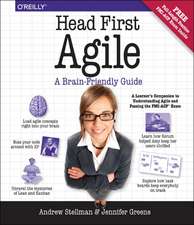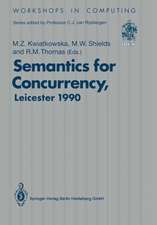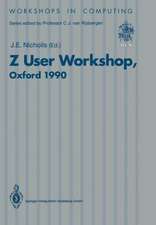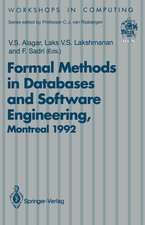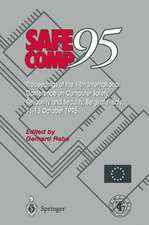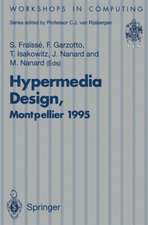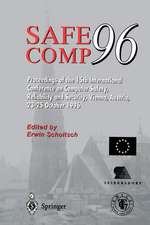Software Reuse
Traducere de I. Craig Autor Bernard Coulangeen Limba Engleză Paperback – 18 noi 1997
Preț: 657.09 lei
Preț vechi: 821.36 lei
-20% Nou
Puncte Express: 986
Preț estimativ în valută:
125.73€ • 131.63$ • 104.04£
125.73€ • 131.63$ • 104.04£
Carte tipărită la comandă
Livrare economică 01-07 aprilie
Preluare comenzi: 021 569.72.76
Specificații
ISBN-13: 9783540760849
ISBN-10: 3540760849
Pagini: 308
Ilustrații: 1
Dimensiuni: 155 x 235 x 16 mm
Greutate: 0.5 kg
Ediția:Softcover reprint of the original 1st ed. 1998
Editura: SPRINGER LONDON
Colecția Springer
Locul publicării:London, United Kingdom
ISBN-10: 3540760849
Pagini: 308
Ilustrații: 1
Dimensiuni: 155 x 235 x 16 mm
Greutate: 0.5 kg
Ediția:Softcover reprint of the original 1st ed. 1998
Editura: SPRINGER LONDON
Colecția Springer
Locul publicării:London, United Kingdom
Public țintă
ResearchDescriere
Software
Reuse
is
a
state
of
the
art
book
concerning
all
aspects
of
software
reuse.
It
does
away
with
the
hype
and
shows
the
reality.
Different
techniques
are
presented
which
enable
software
reuse
and
the
author
demonstrates
why
object-oriented
methods
are
better
for
reuse
than
other
approaches.
The
book
details
the
different
factors
to
take
into
account
when
managing
reusable
components:
characterisation,
identification,
building,
verification,
storage,
search,
adaptation,
maintenance
and
evolution.
Comparisons
and
description
of
various
types
of
companies
that
could
benefit
from
applying
reuse
techniques
are
included
outlining,
amongst
other
things,
increased
profitability
and
likely
problems
that
might
arise
from
the
purchase
and
selling
of
reuse
tools
and
components.
Based
on
a
real
experience
of
software
reuse
in
a
company
with
a
bibliography
of
more
than
200
references
provided,
this
book
is
a
'must
have'
for
all
those
working
in
the
software
reuse
field.
Cuprins
1
Hopes
and
Myths.-
1.1
Reuse.-
1.2
Hopes
for
reuse.-
1.3
Reuse
is
object-oriented.-
1.4
Getting
to
the
bottom
of
the
myths.-
1.5
The
dream
collapses.-
1.6
What
reality?.-
1.7
Objectives
of
this
book.-
1.8
Organisation.-
2
Techniques
for
Reuse.-
2.1
Introduction.-
2.1.1
Productivity.-
2.1.2
Maintainability.-
2.1.3
Reliability.-
2.1.4
Extensibility.-
2.1.5
“Usability”.-
2.1.6
Adaptability.-
2.2
Copying.-
2.2.1
Description.-
2.2.2
Use.-
2.2.3
Evaluation
according
to
the
criteria.-
2.2.4
Evaluation.-
2.3
Pre-processing.-
2.3.1
Description.-
2.3.2
Use.-
2.3.3
Evaluation
according
to
the
criteria.-
2.3.4
Evaluation.-
2.4
Libraries.-
2.4.1
Description.-
2.4.2
Use.-
2.4.3
Evaluation
according
to
the
criteria.-
2.4.4
Evaluation.-
2.5
Packages.-
2.5.1
Description.-
2.5.2
Use.-
2.5.3
Evaluation
according
to
the
criteria.-
2.5.4
Evaluation.-
2.6
Objects
(or
modularity).-
2.6.1
Description.-
2.6.2
Use.-
2.6.3
Evaluation
according
to
the
criteria.-
2.6.4
Evaluation.-
2.7
Genericity
of
objects
and
packages.-
2.7.1
Description.-
2.7.2
Use.-
2.7.3
Evaluation
according
to
the
criteria.-
2.7.4
Evaluation.-
2.8
Object
orientation.-
2.8.1
Description.-
2.8.2
Use.-
2.8.3
Evaluation
according
to
the
criteria.-
2.8.4
Evaluation.-
2.9
Conclusion.-
2.10
Back
to
the
myths.-
2.11
Chapter
summary.-
3
Development
Cycles.-
3.1
The
V
Cycle.-
3.1.1
Specification
phase
(or
analysis
phase).-
3.1.2
General
design
phase.-
3.1.3
Detailed
design
phase.-
3.1.4
Coding
phase.-
3.1.5
Unit
test
phase.-
3.1.6
Integration
phase.-
3.1.7
Validation
phase.-
3.1.8
And
reuse
in
all
of
this?.-
3.2
Spiral
cycle.-
3.3
The
X
cycle.-
3.3.1
Acquisition
phase.-
3.3.2
Archiving
phase.-
3.3.3
Adaptation
of
the
specification,
general
and
detailed
design
phases.-
3.3.4
Incremental
development.-
3.4
Ingredients
for
reuse.-
3.5
Chapter
summary.-
4
Characterising
Reusable
Components.-
4.1
The
different
types
of
reusable
components.-
4.2
Characterisation
of
specification
components.-
4.2.1
Methods
emphasising
data.-
4.2.2
Object
diagrams.-
4.2.3
Methods
emphasising
functions.-
4.2.4
Methods
emphasising
dynamics.-
4.2.5
Object-oriented
methods.-
4.2.6
Characterisation
common
to
the
analysis
components.-
4.3
Characterisation
of
design
components.-
4.4
Characterisation
of
code
components.-
4.4.1
Languages
that
are
not
structured,
languages
that
are.-
4.4.2
Modular
languages.-
4.4.3
Object-oriented
languages.-
4.5
Other
types
of
components.-
4.6
Examples
of
reusable
code.-
4.6.1
Code
components.-
4.6.2
Analysis
components.-
4.6.3
Design
components.-
4.7
Chapter
summary.-
5
How
to
Identify
Reusable
Components.-
5.1
Introduction.-
5.2
Identification
before
development.-
5.3
Identification
during
development.-
5.4
Identification
after
development.-
5.4.1
Identification
of
specification
components.-
5.4.2
Identification
of
design
components.-
5.4.3
Identification
of
code
components.-
5.5
Identification
without
reference
to
development.-
5.6
Chapter
summary.-
6
Building
Reusable
Components.-
6.1
Introduction.-
6.2
Construction
of
analysis
components.-
6.2.1
Informal
analysis.-
6.2.2
Entity-relation
methods.-
6.2.3
Object
diagrams.-
6.2.4
Data
flow.-
6.2.5
Automata.-
6.2.6
Composite
methods.-
6.3
Construction
of
design
objects.-
6.4
Construction
of
code
components.-
6.4.1
Languages
without
data
structures.-
6.4.2
Languages
with
structured
data.-
6.4.3
Modular
languages.-
6.4.4
Object-oriented
languages.-
6.5
Backing
up
and
restoring
information.-
6.6
Chapter
summary.-
7
Component
certification.-
7.1
Definition.-
7.2
Why
certify?.-
7.2.1
Failure
of
a
reuse
policy.-
7.2.2
Waste
of
time
during
development.-
7.2.3
Risking
several
projects
at
the
same
time.-
7.3
How
are
components
certified?.-
7.4
Certification
of
analysis
components.-
7.4.1
Entity-relations.-
7.4.2
Data
flows.-
7.4.3
Automata.-
7.4.4
Object
diagrams.-
7.4.5
Object-oriented
methods.-
7.5
Certification
of
design
components.-
7.6
Certification
of
code
components.-
7.6.1
Code
does
not
correspond
to
its
documentation.-
7.6.2
Code
errors.-
7.6.3
Poorly
functioning
code
in
some
contexts.-
7.6.4
Code
that’s
too
complex.-
7.7
Chapter
summary.-
8
Component
Storage.-
8.1
Introduction.-
8.2
What
must
be
stored?.-
8.3
Classification
techniques.-
8.3.1
Keywords.-
8.3.2
Characteristic
words.-
8.3.3
Hierarchical
classification.-
8.3.4
Facets.-
8.3.5
The
best
classification
technique.-
8.3.6
Some
words
on
databases.-
8.4
Configuration
management.-
8.5
Where
to
store?.-
8.6
Saving
components.-
8.7
Tools.-
8.8
Chapter
summary.-
9
Finding
Components.-
9.1
Introduction.-
9.2
Expression
of
need:
when?.-
9.3
Expression
of
need:
how?.-
9.3.1
Reuse
through
habit.-
9.3.2
Reuse
by
navigation
in
a
component
base.-
9.3.3
Search
by
requests.-
9.3.4
Keyword
search.-
9.3.5
Search
by
facets.-
9.3.6
Comparison.-
9.4
Automatic
search
for
components.-
9.4.1
Reusing
while
analysing.-
9.4.2
Informal
analysis
components.-
9.4.3
Entity-relation
components
in
an
analysis.-
9.4.4
Object-oriented
analysis
components.-
9.4.5
Components
in
a
functional
analysis.-
9.4.6
Components
in
an
automata-based
analysis.-
9.4.7
Components
of
a
composite
analysis.-
9.4.8
Design
components.-
9.4.9
Code
components.-
9.5
Finding
good
components.-
9.6
Component
retrieval.-
9.7
After
sales
service.-
9.8
Learning
from
search.-
9.8.1
Searches
which
fail.-
9.8.2
Unused
components.-
9.8.3
Unsuitable
components.-
9.8.4
Useof
the
base.-
9.9
Chapter
summary.-
10
Adapting
Components.-
10.1
Reuse
or
not?.-
10.2
General
rules
for
the
adaptation
of
components.-
10.2.1
Don’t
say
the
component
is
bad.-
10.2.2
Don’t
get
a
fixation
about
names.-
10.3
Adaptation
of
analysis
components.-
10.3.1
Informal
analysis
components.-
10.3.2
Entity-relation
analysis
components.-
10.3.3
Object-based
component
analysis.-
10.3.4
Data
flow
analysis
components.-
10.3.5
Automata
analysis
components.-
10.3.6
Composite
analysis
components.-
10.4
Adaptation
of
design
components.-
10.5
Adaptation
of
code
components.-
10.5.1
Code
that
is
not
object-oriented.-
10.5.2
Object-oriented
code.-
10.6
Optimising
reuse.-
10.7
Inheritance
and
reuse.-
10.7.1
Single
inheritance.-
10.7.2
Multiple
inheritance.-
10.7.3
Repeated
inheritance.-
10.8
Chapter
summary.-
11
Maintenance
and
Evolution
of
Components.-
11.1
Introduction.-
11.2
Identification
of
extensions.-
11.3
Versions
and
configurations.-
11.4
Processes.-
11.5
How
do
you
make
extensions?.-
11.5.1
Name
change.-
11.5.2
Informal
analysis
components.-
11.5.3
Entity-relation
analysis
components.-
11.5.4
Analysis
component
by
objects.-
11.5.5
Analysis
components
by
data
flow.-
11.5.6
Component
design
using
automata.-
11.5.7
Design
component.-
11.5.8
Code
components.-
11.6
How
to
keep
components
reliable.-
11.7
Chapter
summary.-
12
Organisation
for
Reuse.-
12.1
New
state
of
mind.-
12.2
New
organisation.-
12.2.1
“Isolated
manufacture”
organisation.-
12.2.2
“One
constructor
per
team”
organisation.-
12.2.3
“Common
provider
group”
organisation.-
12.2.4
“Component
fabrication
centre”
organisation.-
12.2.5
“Centre
of
excellence”
organisation.-
12.2.6
“Advisory
group”
organisation.-
12.2.7
Conclusions
about
organisation.-
12.3
New
methods.-
12.4
New
tools.-
12.5
New
skills.-
12.5.1
Librarian.-
12.5.2
Component
maker.-
12.5.3
Component
“certifier”.-
12.5.4
Component
consultant.-
12.6
New
motivations.-
12.7
Starting
to
reuse.-
12.8
How
to
launchreuse.-
12.9
Chapter
summary.-
13
Possible
Profit.-
13.1
Myth.-
13.2
In
reality.-
13.3
The
price
of
components.-
13.4
Cost
of
components
to
a
project.-
13.5
Cost
of
a
project
with
reuse.-
13.6
Hypotheses.-
13.7
First
simulation.-
13.8
Improving
the
simulation.-
13.9
Impact
of
maintenance.-
13.10
Impact
of
reuse.-
13.11
Purchase
of
components.-
13.12
Resistance
to
evolution.-
13.13
Conclusion.-
13.14
Chapter
summary.-
14
Buying
and
Selling
Components.-
14.1
Buying
components.-
14.1.1
Which
components
to
choose?.-
14.1.2
When
will
components
be
standardised?.-
14.1.3
What
to
do
while
waiting
for
standardisation?.-
14.1.4
Standards
and
extensions.-
14.2
Sale
of
components.-
14.2.1
In
what
form
to
sell
components.-
14.2.2
Must
components
be
paid
for?.-
14.2.3
To
whom
do
modified
components
belong?.-
14.2.4
Component
purchase
and
dependence.-
14.3
Chapter
summary.-
15
Experience
with
Reuse.-
15.1
History.-
15.2
First
experience
with
object
orientation.-
15.3
First
version
of
the
Verilog
environment.-
15.3.1
Language
limits.-
15.3.2
Configuration
management
problems.-
15.3.3
Task
sharing
problems.-
15.4
Second
version
of
the
environment.-
15.4.1
Language.-
15.4.2
Configuration
management.-
15.5
Organisation.-
15.6
Statistics.-
15.6.1
Class
size.-
15.6.2
Number
of
attributes.-
15.6.3
Number
of
methods.-
15.6.4
Inheritance.-
15.6.5
Used
classes.-
15.6.6
Class
complexity.-
15.7
Examples
of
components.-
15.7.1
Base
class:
kernel_sys.-
15.7.2
structure_sys:
data
structures.-
15.7.3
tool_sys:
utilities.-
15.7.4
file_sys:
files.-
15.7.5
reference_sys:
referencing
objects.-
15.7.6
ero_sys:
entity-relation
systems.-
15.7.7
asnl_sys:
backup
and
restore
asn1.-
15.7.8
p_base_sys:
graphic
base.-
15.7.9
g_graphic_sys:
encapsulation
of
MOTIF
objects.-
15.7.10
editorsys:
multiview
kernel.-
15.7.11
Drawing.-
15.8
Re-sults
obtained.-
15.8.1
Re-use
global
to
the
company.-
15.8.2
Re-use
by
domain.-
15.8.3
Productivity.-
15.8.4
Quality.-
15.8.5
Development.-
15.9
Conclusion.-
15.10
Chapter
summary.-
16
Conclusions.-
16.1
To
know
more.-
16.2
Main
ideas.-
16.3
Acknowledgements.-
References.
Caracteristici
*
A
state
of
the
art
book
concerning
all
aspects
of
software
reuse,
which
is
based
on
real
experience
of
software
reuse
in
a
company
*
Shows
companies
how
to
increase
profitability









